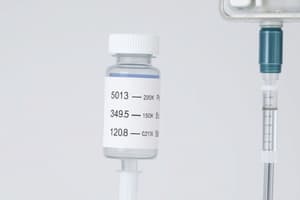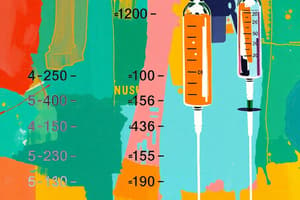Podcast
Questions and Answers
What is the primary purpose of controlling the flow rate in IV fluid administration?
What is the primary purpose of controlling the flow rate in IV fluid administration?
- To prevent electrolyte imbalances
- To ensure the correct dosage of medication
- To monitor the patient's heart rate
- To prevent the IV fluid from being administered too quickly or too slowly (correct)
What should be done if an IV administration set or solution becomes contaminated with a nonsterile surface?
What should be done if an IV administration set or solution becomes contaminated with a nonsterile surface?
- Increase the flow rate to compensate for potential infection
- Replace the contaminated set with a new one (correct)
- Assess the patient for signs of infection
- Continue infusion with a new IV solution
A patient is receiving IV fluids at a rate of 150 mL/h. If the IV set has a drop factor of 15 drops/mL, what is the drip rate in drops/min?
A patient is receiving IV fluids at a rate of 150 mL/h. If the IV set has a drop factor of 15 drops/mL, what is the drip rate in drops/min?
- 375 drops/min (correct)
- 150 drops/min
- 225 drops/min
- 450 drops/min
What is the main difference between a macro drip set and a micro drip set?
What is the main difference between a macro drip set and a micro drip set?
What is the recommended infusion rate for keeping a vein open, or TKVO?
What is the recommended infusion rate for keeping a vein open, or TKVO?
A patient is ordered to receive 500 mL of IV fluids over 4 hours. What is the flow rate in mL/h?
A patient is ordered to receive 500 mL of IV fluids over 4 hours. What is the flow rate in mL/h?
How often should an infusing peripheral IV site be assessed?
How often should an infusing peripheral IV site be assessed?
What is a potential complication of IV therapy?
What is a potential complication of IV therapy?
What is the term for the number of drops in one milliliter used in IV fluid administration?
What is the term for the number of drops in one milliliter used in IV fluid administration?
A patient is receiving IV fluids at a rate of 75 mL/h. If the patient is ordered to receive 1000 mL over 8 hours, is the current flow rate correct?
A patient is receiving IV fluids at a rate of 75 mL/h. If the patient is ordered to receive 1000 mL over 8 hours, is the current flow rate correct?
What is required for the administration of IV injections?
What is required for the administration of IV injections?
What should be used in giving IV injections according to the Board of Nursing Resolution No. 8 Sec. 30 (c) ART?
What should be used in giving IV injections according to the Board of Nursing Resolution No. 8 Sec. 30 (c) ART?
What is the first step in calculating the flow rate of IV fluid?
What is the first step in calculating the flow rate of IV fluid?
What type of IV fluid is designed to increase extracellular fluid volume?
What type of IV fluid is designed to increase extracellular fluid volume?
If a doctor orders 1000 mL of IV fluid to be administered over 8 hours, how many minutes is the total infusion time?
If a doctor orders 1000 mL of IV fluid to be administered over 8 hours, how many minutes is the total infusion time?
What is the conversion factor from milliliters to liters?
What is the conversion factor from milliliters to liters?
A patient is prescribed 2 grams of a medication, and the vial contains 500 milligrams per 10 milliliters. How many milliliters will the patient receive?
A patient is prescribed 2 grams of a medication, and the vial contains 500 milligrams per 10 milliliters. How many milliliters will the patient receive?
What is the formula for calculating the flow rate of IV fluid?
What is the formula for calculating the flow rate of IV fluid?
Flashcards are hidden until you start studying




